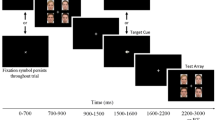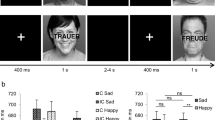Abstract
A critical cognitive symptom that is commonly involved in social anxiety and depression is attentional deficit. However, the functional relationship between attentional deficit and these two disorders remains poorly understood. Here, we behaviorally disentangled the three key attentional components (alerting, orienting, and executive control) using the established attentional network task (ANT) to investigate how social anxiety and depression are related to deficits in these attention components. We identified a double dissociation between the symptoms of social anxiety and depression and the attentional component deficits when processing non-emotional stimuli. While individuals vulnerable to social anxiety exhibited deficits in the orienting component, individuals vulnerable to depression were impaired in the executive control component. Our findings showed that social anxiety and depression were associated with deficits in different attentional components, which are not specific to emotional information.
Similar content being viewed by others
References
Abundis-Gutiérrez, A., Checa, P., Castellanos, C., and Rosario Rueda, M. (2014). Electrophysiological correlates of attention networks in childhood and early adulthood. Neuropsychologia 57, 78–92.
Adólfsdóttir, S., Sørensen, L., and Lundervold, A.J. (2008). The attention network test: a characteristic pattern of deficits in children with ADHD. Behav Brain Funct 4, 9.
American Psychiatric Association (APA). (2013). Diagnostic and Statistical Manual of Mental Disorders V—Text Revision (Washington, DC: American Psychiatric Press).
Amir, N., Beard, C., Burns, M., and Bomyea, J. (2009). Attention modification program in individuals with generalized anxiety disorder. J Abnorm Psychol 118, 28–33.
Bar-Haim, Y., Lamy, D., Pergamin, L., Bakermans-Kranenburg, M.J., and van IJzendoorn, M.H. (2007). Threat-related attentional bias in anxious and nonanxious individuals: A meta-analytic study. Psychol Bull 133, 1–24.
Beck, A.T., Steer, R.A., and Brown, G.K. (1996). Manual for the Beck Depression Inventory—II. (San Antonio, TX: Psychological Corporation).
Bryson, S.E., Landry, R., Czapinski, P., and Connell, B. (2004). Autistic Spectrum Disorders: Causal mechanisms and recent findings on attention and emotion. Int J Spec Edu 19, 14–22.
Calder, A.J., Beaver, J.D., Winston, J.S., Dolan, R.J., Jenkins, R., Eger, E., and Henson, R.N.A. (2007). Separate coding of different gaze directions in the superior temporal sulcus and inferior parietal lobule. Curr Biol 17, 20–25.
Cerdá, M., Sagdeo, A., and Galea, S. (2008). Comorbid forms of psychopathology: key patterns and future research directions. Epidemiol Rev 30, 155–177.
Clark, D.M., and Wells, A. (1995). A cognitive model of social phobia. In R. Heimberg, M. Liebowitz, D.A. Hope, and F.R. Schneier, ed. Social Phobia: Diagnosis, Assessment, and Treatment. (New York, NY: Guilford Press), pp. 69–93.
Compton, R.J. (2000). Ability to disengage attention predicts negative affect. Cogn Emot 14, 401–415.
Dalgleish, T., Taghavi, R., Neshat-Doost, H., Moradi, A., Canterbury, R., and Yule, W. (2003). Patterns of processing bias for emotional information across clinical disorders: a comparison of attention, memory, and prospective cognition in children and adolescents with depression, generalized anxiety, and posttraumatic stress disorder. J Clin Child Adolesc Psychol 32, 10–21.
Davidson, R.J., Pizzagalli, D., Nitschke, J.B., and Putnam, K. (2002). Depression: Perspectives from affective neuroscience. Annu Rev Psychol 53, 545–574.
Derryberry, D., and Rothbart, M.K. (1988). Arousal, affect, and attention as components of temperament. J Personal Soc Psychol 55, 958–966.
Eysenck, M.W., Derakshan, N., Santos, R., and Calvo, M.G. (2007). Anxiety and cognitive performance: Attentional control theory. Emotion 7, 336–353.
Fan, J., Gu, X., Guise, K.G., Liu, X., Fossella, J., Wang, H., and Posner, M. I. (2009). Testing the behavioral interaction and integration of attentional networks. Brain Cogn 70, 209–220.
Fan, J., McCandliss, B.D., Sommer, T., Raz, A., and Posner, M.I. (2002). Testing the efficiency and independence of attentional networks. J Cogn Neurosci 14, 340–347.
Fernandez-Duque, D., and Black, S.E. (2006). Attentional networks in normal aging and Alzheimer’s disease. Neuropsychology 20, 133–143.
Fung, K., and Alden, L.E. (2016). Once hurt, twice shy: social pain contributes to social anxiety. Emotion 17, 231–239.
Gentili, C., Cristea, I.A., Angstadt, M., Klumpp, H., Tozzi, L., Phan, K.L., and Pietrini, P. (2016). Beyond emotions: a meta-analysis of neural response within face processing system in social anxiety. Exp Biol Med (Maywood) 241, 225–237.
Hankin, B.L., Gibb, B.E., Abela, J.R.Z., and Flory, K. (2010). Selective attention to affective stimuli and clinical depression among youths: role of anxiety and specificity of emotion. J Abnorm Psychol 119, 491–501.
Heeren, A., Maurage, P., and Philippot, P. (2015). Revisiting attentional processing of non-emotional cues in social anxiety: a specific impairment for the orienting network of attention. Psych Res 228, 136–142.
Heeren, A., and McNally, R.J. (2016). An integrative network approach to social anxiety disorder: the complex dynamic interplay among attentional bias for threat, attentional control, and symptoms. J Anxiety Disord 42, 95–104.
Heimberg, R.C., Brozovich, F.A., and Rapee, R.M. (2010). A cognitive behavioral model of social anxiety disorder: update and extension. Social Anxiety 24, 753–771.
Hester, R., and Garavan, H. (2005). Working memory and executive function: The influence of content and load on the control of attention. Mem Cogn 33, 221–233.
Hofmann, S.G. (2007). Cognitive factors that maintain social anxiety disorder: a comprehensive model and its treatment implications. Cogn Behav Ther 36, 193–209.
Hu, P., Fan, J., Xu, P., Zhou, S., Zhang, L., Tian, Y., and Wang, K. (2013). Attention network impairments in patients with focal frontal or parietal lesions. Neurosci Lett 534, 177–181.
Irle, E., Barke, A., Lange, C., and Ruhleder, M. (2014). Parietal abnormalities are related to avoidance in social anxiety disorder: a study using voxel-based morphometry and manual volumetry. Psych Res Neuroimag 224, 175–183.
Johnson, K.A., Robertson, I.H., Barry, E., Mulligan, A., Dâibhis, A., Daly, M., Watchorn, A., Gill, M., and Bellgrove, M.A. (2008). Impaired conflict resolution and alerting in children with ADHD: evidence from the Attention Network Task (ANT). J Child Psychol Psych 49, 1339–1347.
Kaiser, S., Unger, J., Kiefer, M., Markela, J., Mundt, C., and Weisbrod, M. (2003). Executive control deficit in depression: Event-related potentials in a Go/Nogo task. Psych Res Neuroimag 122, 169–184.
Kendall, P.C., and Watson, D., ed. (1989). Anxiety and Depression: Distinctive and overlapping features. (San Diego, CA: Academic Press).
Kessler, R.C., Berglund, P., Demler, O., Jin, R., Merikangas, K.R., and Walters, E.E. (2005). Lifetime prevalence and age-of-onset distributions of DSM-Iv disorders in the national comorbidity survey replication. Arch Gen Psychiatry 62, 593.
Kircanski, K., Joormann, J., and Gotlib, I.H. (2015). Attention to emotional information in social anxiety disorder with and without co-occurring depression. Cogn Ther Res 39, 153–161.
Konrad, K., Neufang, S., Hanisch, C., Fink, G.R., and Herpertz-Dahlmann, B. (2006). Dysfunctional attentional networks in children with attention deficit/hyperactivity disorder: evidence from an event-related functional magnetic resonance imaging study. Biol Psychiatry 59, 643–651.
Koster, E.H.W., Crombez, G., Verschuere, B., and De Houwer, J. (2004). Selective attention to threat in the dot probe paradigm: Differentiating vigilance and difficulty to disengage. Behav Res Ther 42, 1183–1192.
De Lissnyder, E., Koster, E.H.W., Derakshan, N., and De Raedt, R. (2010). The association between depressive symptoms and executive control impairments in response to emotional and non-emotional information. Cogn Emot 24, 264–280.
Mathews, A., and MacLeod, C. (2005). Cognitive vulnerability to emotional disorders. Annu Rev Clin Psychol 1, 167–195.
Mattick, R.P., and Clarke, J.C. (1998). Development and validation of measures of social phobia scrutiny fear and social interaction anxiety. Behav Res Ther 36, 455–470.
Mogg, K., and Bradley, B.P. (2018). Anxiety and threat-related attention: cognitive-motivational framework and treatment. Trends Cogn Sci 22, 225–240.
Mogg, K., Mathews, A., and Eysenck, M. (1992). Attentional bias to threat in clinical anxiety states. Cognition Emotion 149–159.
Moriya, J., and Tanno, Y. (2009). Dysfunction of attentional networks for non-emotional processing in negative affect. Cogn Emot 23, 1090–1105.
Nestor, P.G., Kubicki, M., Spencer, K.M., Niznikiewicz, M., McCarley, R. W., and Shenton, M.E. (2007). Attentional networks and cingulum bundle in chronic schizophrenia. Schizophr Res 90, 308–315.
Peckham, A.D., McHugh, R.K., and Otto, M.W. (2010). A meta-analysis of the magnitude of biased attention in depression. Depress Anxiety 30, 1135–1142.
Petersen, S.E., and Posner, M.I. (2012). The attention system of the human brain: 20 years after. Annu Rev Neurosci 35, 73–89.
Posner, M.I., and Petersen, S.E. (1990). The attention system of the human brain. Annu Rev Neurosci 13, 25–42.
Posner, M.I., and Rothbart, M.K. (2007). Research on attention networks as a model for the integration of psychological science. Annu Rev Psychol 58, 1–23.
Posner, M.I., Rothbart, M.K., Sheese, B.E., and Voelker, P. (2012). Control networks and neuromodulators of early development. Dev Psychol 48, 827–835.
Roberts, K.E., Hart, T.A., and Eastwood, J.D. (2010). Attentional biases to social and health threat words in individuals with and without high social anxiety or depression. Cogn Ther Res 34, 388–399.
Rossignol, M., Philippot, P., Bissot, C., Rigoulot, S., and Campanella, S. (2012). Electrophysiological correlates of enhanced perceptual processes and attentional capture by emotional faces in social anxiety. Brain Res 1460, 50–62.
Rothbart, M.K., Ziaie, H., and O’Boyle, C.G. (1992). Self-regulation and emotion in infancy. New Dir Child Dev 7–23.
Rothbart, M.K., and Rueda, M.R. (2005). The development of effortful control. In U. Mayr, E. Awh, and S.W. Keele, ed. Decade of Behavior. Developing Individuality in the Human Brain: A Tribute to Michael I. Posner. (American Psychological Association), pp. 167–188.
Rothbart, M.K., Sheese, B.E., Rueda, M.R., and Posner, M.I. (2011). Developing mechanisms of self-regulation in early life. Emot Rev 3, 207–213.
Siegle, G.J., Carter, C.S., and Thase, M.E. (2006). Use of FMRI to predict recovery from unipolar depression with cognitive behavior therapy. Am J Psych 163, 735–738.
Sheehan, D.V., Lecrubier, Y., Harnett-Sheehan, K., Amorim, P.A., Janavs, J., Weiller, E.H.T., Hergueta, T., Baker, R.D.G., and Dunbar, G.C.L. (1998). The Mini-International Neuropsychiatric Interview (M.I.N.I.): The development and validation of a structured diagnostic psychiatric interview for DSM-IV and ICD-10. J Clin Psychiatry 59(Suppl 20), 22–33, quiz 34–57.
Smith, E.E., and Jonides, J. (1999). Storage and executive processes in the frontal lobes. Science 283, 1657–1661.
Soutschek, A., and Schubert, T. (2013). Domain-specific control mechanisms for emotional and nonemotional conflict processing. Cognition 126, 234–245.
Spielberger, C.D., Gorsuch, R.L., Lushene, R., Vagg, P.R., and Jacobs, G.A. (1983). Manual for the State-Trait Anxiety Inventory (Form Y). (Palo Alto, CA: Mind Garden).
Wang, K., Fan, J., Dong, Y., Wang, C.Q., Lee, T.M.C., and Posner, M.I. (2005) Selective impairment of attentional networks of orienting and executive control in schizophrenia. Schizophr Res 78, 235–241.
Wang, L., LaBar, K.S., Smoski, M., Rosenthal, M.Z., Dolcos, F., Lynch, T. R., Krishnan, R.R., and McCarthy, G. (2008) Prefrontal mechanisms for executive control over emotional distraction are altered in major depression. Psych Res Neuroimag 163, 143–155.
Watts, F.N., and Sharrock, R. (1985). Description and measurement of concentration problems in depressed patients. Psychol Med 15, 317–326.
Westlye, L.T., Grydeland, H., Walhovd, K.B., and Fjell, A.M. (2011). Associations between regional cortical thickness and attentional networks as measured by the attention network test. Cereb Cortex 21, 345–356.
Williams, R.S., Biel, A.L., Wegier, P., Lapp, L.K., Dyson, B.J., and Spaniol, J. (2016). Age differences in the attention network test: evidence from behavior and event-related potentials. Brain Cogn 102, 65–79.
Wittchen, H.U., Zhao, S., Kessler, R.C., and Eaton, W.W. (1994). DSM-III-R generalized anxiety disorder in the national comorbidity survey. Arch Gen Psychiatry 51, 355–364.
Xuan, B., Mackie, M.A., Spagna, A., Wu, T., Tian, Y., Hof, P.R., and Fan, J. (2016) The activation of interactive attentional networks. Neuroimage 129, 308–319.
Ye, D., Qian, M., Liu, X., and Chen, X. (2007). The revision of Social Interaction Anxiety Scale and Social Phobia Scale. Chin J Clin Psychol 15, 115–119.
Yiend, J. (2010). The effects of emotion on attention: a review of attentional processing of emotional information. Cogn Emot 24, 3–47.
Yoon, K.L., Vidaurri, D.N., Joormann, J., and De Raedt, R. (2015). Social anxiety and narrowed attentional breadth toward faces. Emotion 15, 682–686.
Author information
Authors and Affiliations
Corresponding authors
Ethics declarations
Compliance and ethics The author(s) declare that they have no conflict of interest.
Rights and permissions
About this article
Cite this article
Wang, H., Mo, C. & Fang, F. Dissociated deficits in attentional networks in social anxiety and depression. Sci. China Life Sci. 63, 1071–1078 (2020). https://doi.org/10.1007/s11427-019-1624-5
Received:
Accepted:
Published:
Issue Date:
DOI: https://doi.org/10.1007/s11427-019-1624-5




